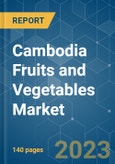Cambodia's fruits and vegetable market is projected to register a CAGR of 2.5% during the forecast period.
This product will be delivered within 2 business days.
Key Highlights
- The demand for fresh fruits, such as apples, berries, and kiwifruits, is rapidly rising in the country due to the changing consumption patterns and their increasing availability in supermarkets across the country. However, the consumption of most fresh fruits and vegetables is mainly import-dependent, primarily due to the unfavorable climate that hinders domestic production.
- Bananas are the most prominently cultivated fruit in Cambodia. The international demand for bananas, especially from China, has boosted production in the country. The number of Cambodian banana-planting enterprises approved to export to China has increased in recent years. Additionally, the mango industry in the country has become more resilient in recent years, with the rising adoption of improved production and supply chain practices.
- Further, fruit-bearing vegetables, such as tomatoes, were the most widely cultivated vegetables in the country. Cambodia's major vegetable-producing areas include Kandal, Kampong Cham, Siem Reap, and Kampot.
Cambodia Fruits & Vegetables Market Trends
Rise in Demand From Food and Beverage Processing Industry
- The Cambodian food and beverage market significantly developed in recent years, thus, making investments from regional and international brands possible. The growing economic conditions, urbanization, and tourism in top cities like Siem Reap and Phnom Penh are driving Cambodia's processed vegetables and fruits market. Fresh-cut vegetables, dried vegetables, pickles, sauces, fruit juices, ketchup, puree, and wine are essential processed food and beverage products produced and consumed in the country.
- Further, due to the ongoing industrial developments and government support, foreign players look forward to establishing fruit processing companies in the country. For example, Coconut Palm Group Co. Ltd, a leading tropical fruit juice manufacturer, plans to invest in coconut plantations and set up a factory in Cambodia to produce fruit juice in 2020.
- Additionally, in 2022, the Ministry of Commerce called on Korean companies to invest in Cambodian fruit processing plants for mango, banana, and longan to produce quality fruit products that meet strict country-specific import standards. Also, there has been a strong demand in Korea for Cambodian mango products, which has increased domestic production and imports. According to the Ministry of Commerce, the country currently aims to import at least 10,000 metric tons of mangoes from Cambodia annually.
- Moreover, the increased exports of processed products, including sugar-preserved fruits and vegetables from the country, showcase the international demand for processed products and the eventual domestic demand for fruits and vegetables. This will create a need for more fruits and vegetables, thereby increasing production. Thus, the growing food processing industries, government support for the food processing industries, and export demand for fruit juices and other processed products stimulate the growth of the market studied.
Expanding Export Market
- Cambodia has expanded its fruits and vegetable exports significantly in recent years, owing to the rise in demand in the international markets. The Royal Government of Cambodia has made significant agreements with the exporting countries to have direct access to its exports without intermediary partners.
- For instance, the country has gained direct export access to its bananas to China from the General Administration of Customs of China (GACC). According to the Ministry of Agriculture, Forestry, and Fisheries, Cambodia’s exports of fresh bananas reached 218,000 metric tons in the first half of 2022, driven mostly by Chinese demand.
- Furthermore, Vietnam, China, Thailand, Korea, and Japan are major importers of fresh produce from the country. According to figures from the Ministry of Agriculture, Forestry, and Fisheries, the Kingdom exported approximately 265,230 metric tons of fresh mangoes and mango products in 2021, an increase of 146.3% year over year, wherein the Vietnamese market took in just under 199,636.7 metric ton of this shipment.
- In addition, according to the UN COMTRADE, the export of fruits from the country has increased by 43% from 2020 to 2021. Thus, the surplus domestic production for exports and proactive measures taken by Cambodia’s government, which include making trade agreements, are anticipated to boost the exports during the forecast period.
Additional benefits of purchasing the report:
- The market estimate (ME) sheet in Excel format
- 3 months of analyst support
This product will be delivered within 2 business days.
Table of Contents
1 INTRODUCTION
4 MARKET DYNAMICS
5 MARKET SEGMENTATION
6 PRICE TREND ANALYSIS
Methodology

LOADING...










